THE NEED FOR WATER
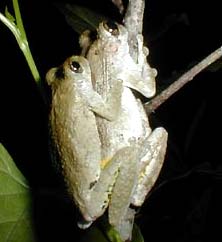
On our Amphibians in General page, it's seen that during the evolution of life on Earth, amphibians such as frogs were the first vertebrate animals to live on land. However, in those early days of vertebrate evolution, eggs with shells hadn't been "invented." Shelled eggs didn't fully develop until reptiles arose. However, sometimes, as with the Squirrel Treefrogs, Hyla squirella, shown at the right, you see frogs mating outside bodies of water.
Part of the explanation is that for some species not much water is needed. Frog eggs normally are surrounded by a kind of jelly that keeps the shell-less eggs moist. Water can soak into such eggs even from a shallow film on vegetation. 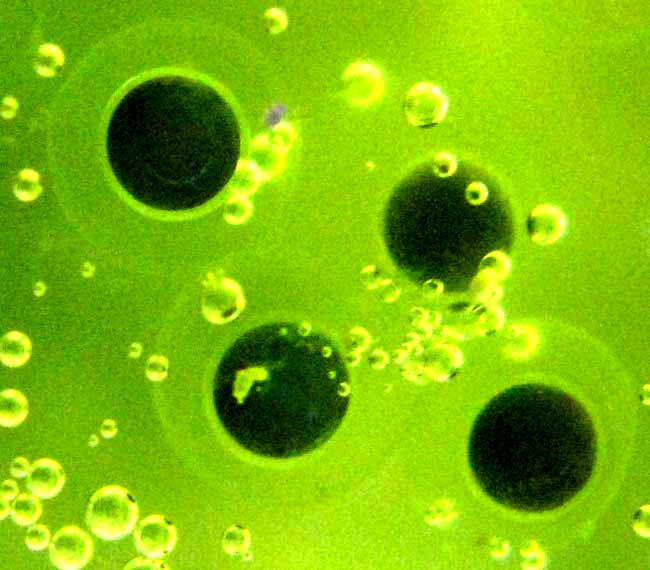 Some treefrog species deposit their eggs on the undersides of leaves overhanging a pool of water. When the eggs hatch, tadpoles fall into the water to complete their development. Normally, however, frog eggs develop in water like the treefrog eggs at the left. In that picture, the black spheres, about the size of a pinhead, is the future frog, the embryo. The hardly visible, halo-like item surrounding the embryo is the jelly capsule. The small, silvery spheres are just air bubbles in the algae-rich water.
Some treefrog species deposit their eggs on the undersides of leaves overhanging a pool of water. When the eggs hatch, tadpoles fall into the water to complete their development. Normally, however, frog eggs develop in water like the treefrog eggs at the left. In that picture, the black spheres, about the size of a pinhead, is the future frog, the embryo. The hardly visible, halo-like item surrounding the embryo is the jelly capsule. The small, silvery spheres are just air bubbles in the algae-rich water.
Below, you see mating Gulf Coast Toads, Bufo valliceps, the male atop a much larger female, as the female extrudes a slender strand of eggs, the male presumably doing his job of squirting sperm over them.
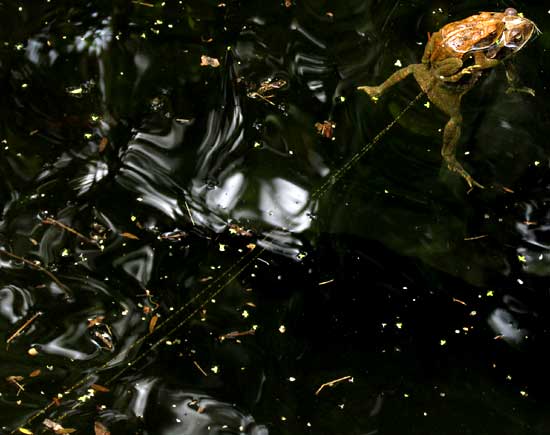
Another part of the explanation of why sometimes you see male frogs clamped atop female frogs outside of water is that the male-atop-female part of frog reproduction can last for as little as five seconds, or as long as months, depending on the species. Of course the actual fertilization of the eggs, when the male's sperm issues onto the eggs, occurs in brief spurts. This male-clamped-atop-female behavior is so important among frogs that it has a special name. It's called "amplexus."
AMPLEXUS
Amplexus is a form of external fertilization. The male frog grasps the female's trunk with his forelimbs and hangs on. In species in which amplexus lasts for a long time, this can make it harder to move around, get food and escape enemies. These are serious problems, but during the early days of vertebrate evolution on land, it was one way to get around the other problem that neither had male penises appeared, enabling eggs to d develop shells inside female bodies... So, yes, male frogs have no penises.
Amplexus by itself doesn't necessarily lead to fertilized eggs. If the female frog isn't "ready," she'll vibrate her body, and the understanding male will release her and look for someone else. If the female doesn't vibrate her body, but doesn't seem particularly interested in mating, the male's grasp somehow may induce the female to be more receptive, so the male may wait, and wait -- to release his sperm -- until they're both "ready."
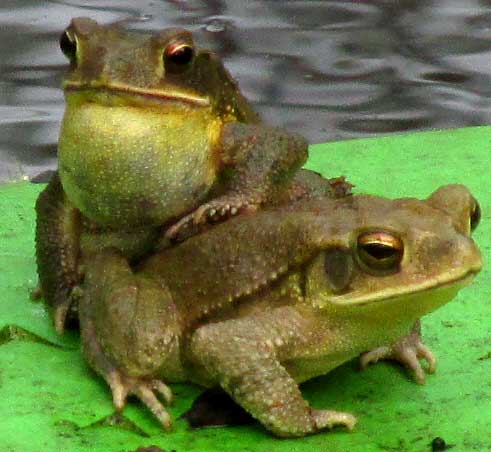
Males during mating season can be hilarious to watch, or disgusting, depending on the observer. For example, at the right you see one male Gulf Coast Toad, Bufo valliceps atop another male Gulf Coast Toad. The male on top had just got into amplexus position, the one on the bottom wouldn't cooperate, so the top male just turned around and began calling for a female, even before getting off the bottom one's back. Another male in this same frog-rich pool of water actually mounted a turtle's head sticking out of the water, but that hadn't been satisfying, either.
Sometimes amplexus really gets out of hand. The amazing picture below shows mating Wood Frogs, Lithobates sylvatica, during amplexus. It was taken by Greg Scott in Wisconsin. Greg writes:
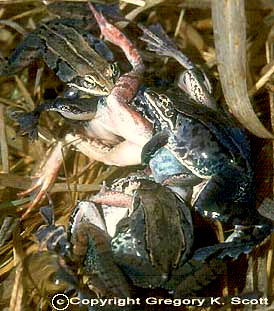 I photographed one unfortunate female ... who had been "attacked" by several males. Each had tried grasping her and in the process of each holding on to a different part of her body they had held her under water long enough that she had drowned.... but they were still holding on to various parts of her body.
I photographed one unfortunate female ... who had been "attacked" by several males. Each had tried grasping her and in the process of each holding on to a different part of her body they had held her under water long enough that she had drowned.... but they were still holding on to various parts of her body.
In other words, the picture shows a dead female frog with several males trying to mate with various part of her body. How could such a crazy thing happen in nature?
In his study of toad amplexus, Dr. Susumu Ishii in Japan 1 found that when adult male toads find almost any pliable object more or less the size of an adult toad during the breeding season, they mount it and try to clasp it.
More amplexus confusion is shown below, showing a male Fowler's Toad, Anaxyrus fowleri clasping a completely different species, a Green Frog, Lithobates clamitans. And of course that won't lead to anything other than disappointment for both parties.
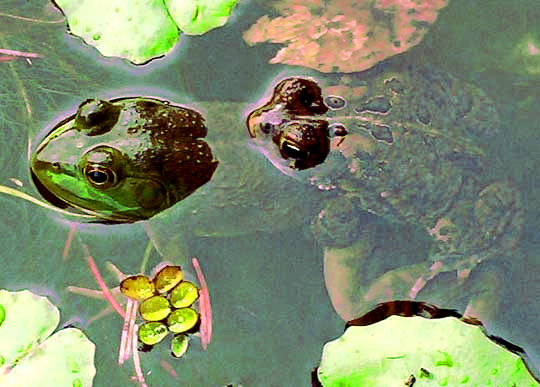
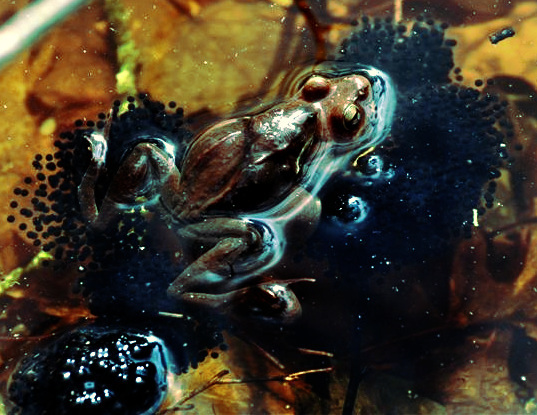 Photo by Tom Tetzner, USFWS, Ninigret National Wildlife Refuge, Rhode Island, USA
Photo by Tom Tetzner, USFWS, Ninigret National Wildlife Refuge, Rhode Island, USAFROG EGGS
On our Frog Classification page we se that there's a "True Frog" Family, the Ranidae, and a Toad Family, the Bufonidae, as well as a Treefrog Family, the Hylidae. In general, "true frogs" lay eggs in clusters, or less often, singly, one at a time. At the right, the Wood Frog's eggs are clustered. In contrast, members of the Toad Family lay eggs connected in long, stringy chains.
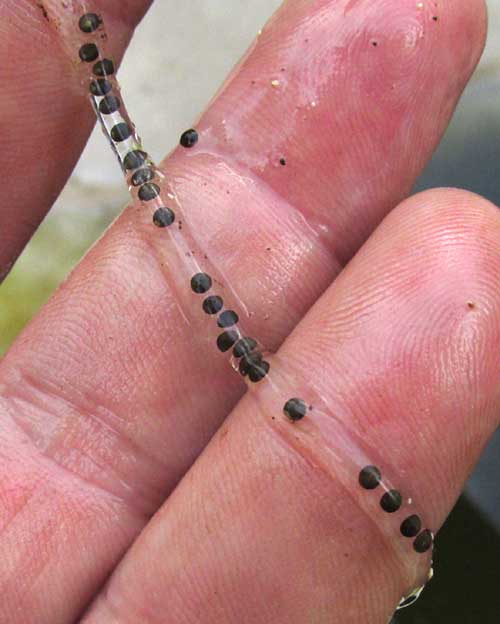
At the left is a close-up of a Gulf Coast Toad's eggs arranged neatly one after another in a stringy chain. If you discover egg masses, let them stay where they are but return to them regularly and watch what happens. The black specks will grow larger and larger and finally the eggs will hatch into tiny, legless tadpoles.
Some frogs don't need much water when they mate. Sometimes a little rain pooled in a curled leaf is all that's needed for a female to deposit her eggs there. When a frog's eggs first make contact with water their protective layers of jelly soak up the water and swell, forming the jelly-like stuff around the black specks.
Below, you see a female Squirrel Treefrog with a belly filled with unfertilized eggs prior to mating, before the male can cover them with sperm. The eggs are seen through her tight belly skin.
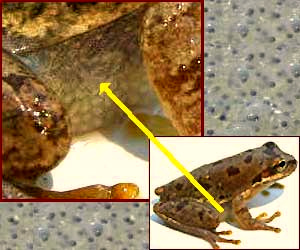
This Squirrel Treefrog had been in a parked car in southern Mississippi and apparently couldn't get to water where she could mate. One day the car was taken to the carwash and the frog hopped out, surely eager to encounter a male of her species, for she was obviously ready. The technical way to refer to an animal like this carrying eggs or young is to say that they are gravid, and this frog is really gravid.
TADPOLES
Below you see some typical Gulf Coast Toad tadpoles a few days after emerging from their eggs. They are at a puddle's edge feeding on the algae that makes their water greenish.
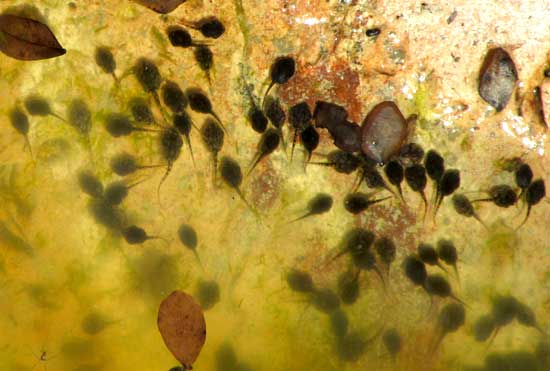
The picture below shows a tadpole about an inch long, probably of a Southern Leopard Frog, Lithobates pipiens. It was captured and put into a jar, brought home, placed on a scanner, scanned, and quickly released back into its puddle. The neat thing about this picture is that it shows not only the spaghetti-like intestines coiling around in the body part, but also see tiny back legs beginning to sprout at the base of the tail.
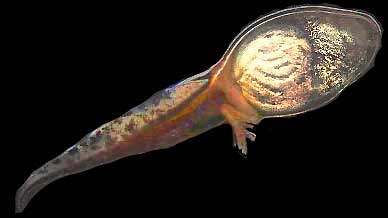
Below is a more developed tadpole of a Gulf Coast Toad:
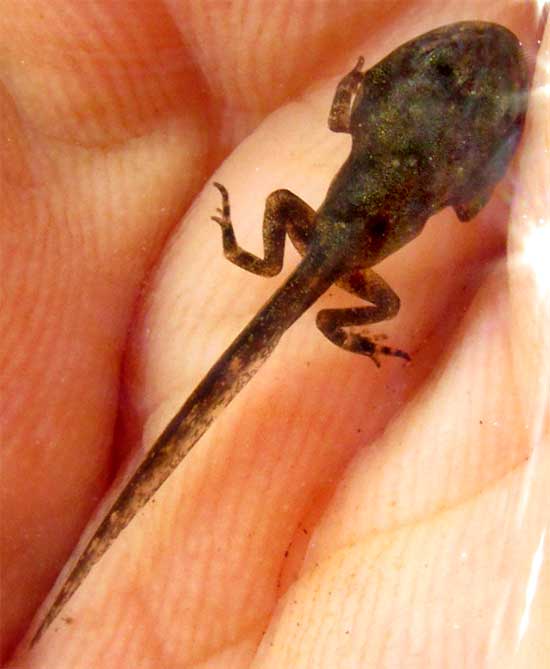
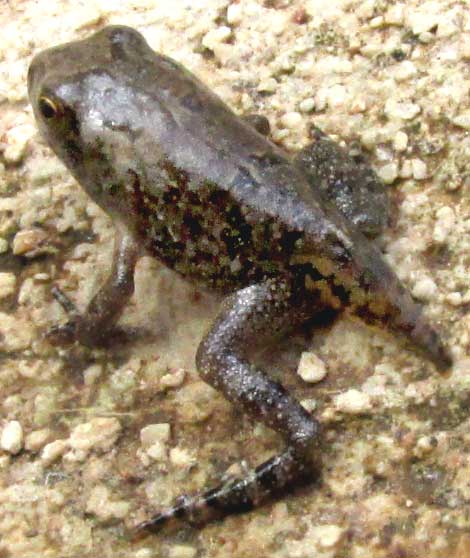 And at the right is a Gulf Coast Toad tadpole almost at the stage where the tail almost has disappeared, being absorbed into the ever-enlarging toad's body. As tadpoles grow, their diet gradually changes from a vegetarian one to a carnivorous one, and they need more and more air. During later stages, they spend lots of time at the water's surface gulping air. Finally, if the puddle of water they're developing in doesn't dry out so that all the tadpoles die, the newly formed frogs who have managed to escape hungry birds, raccoons and the like will hop away to begin their land lives.
And at the right is a Gulf Coast Toad tadpole almost at the stage where the tail almost has disappeared, being absorbed into the ever-enlarging toad's body. As tadpoles grow, their diet gradually changes from a vegetarian one to a carnivorous one, and they need more and more air. During later stages, they spend lots of time at the water's surface gulping air. Finally, if the puddle of water they're developing in doesn't dry out so that all the tadpoles die, the newly formed frogs who have managed to escape hungry birds, raccoons and the like will hop away to begin their land lives.
You may enjoy seeing more tadpole pictures, and reading the stories that go with them, on the Tadpole Page of Naturalist Jim's Newsletter.
REFERENCES:
1 Susumu Ishii and Masanori Itoh. 1992. "Amplexus induces surge of luteinizing hormone in male toads, Bufo japonicus," in General and Comparative Endocrinology 86(1):34-41, abstract accessed from page at https://www.researchgate.net/
